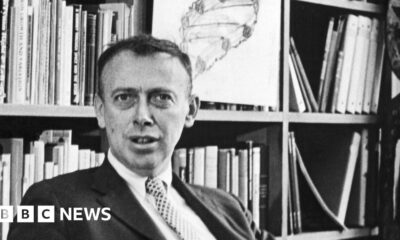Science
Nobel Laureate James Watson, Key DNA Discoverer, Dies at 97

James Watson, the renowned geneticist and co-discoverer of the structure of DNA, passed away on November 6, 2025, at the age of 97. His groundbreaking work, alongside fellow scientist Francis Crick, revolutionized the field of biology and laid the foundation for modern genetics. Despite his significant contributions, Watson’s career was marred by controversy and criticism due to his contentious remarks and personal views.
Born on April 6, 1928, in Chicago, Watson demonstrated extraordinary talent in science from a young age. By 15, he enrolled at the University of Chicago, where he developed a keen interest in genetics. His academic journey led him to Indiana University, where he earned his PhD under the mentorship of Salvador Luria. Watson’s pivotal moment came during a symposium in Naples, Italy, in 1951, where he encountered the first X-ray diffraction images of DNA, sparking his fascination with the molecule.
Revolutionizing Biology
In 1953, Watson and Crick, based at Cambridge University, unveiled the double helical structure of DNA, a discovery that fundamentally altered the understanding of genetic inheritance. They proposed that DNA consists of two strands twisted around each other, with base pairs of adenine (A), thymine (T), guanine (G), and cytosine (C) holding the structure together. This revelation not only elucidated the mechanisms of hereditary information but also paved the way for advancements in various scientific fields, including medicine, archaeology, and criminal science.
Their findings were published in the journal Nature, where they famously suggested that their model hinted at a potential copying mechanism for genetic material. This assertion marked a significant milestone in the quest to understand life at a molecular level.
Watson’s 1968 memoir, The Double Helix, chronicled the dramatic journey of this discovery. While it captivated many, it also drew ire from peers due to its brash tone and the portrayal of their scientific race, which included the use of data obtained from fellow researcher Rosalind Franklin. Franklin’s critical contributions to the understanding of DNA were largely unrecognized during her lifetime, leading to ongoing debates about credit and recognition in scientific research.
A Complex Legacy
Following their Nobel Prize win in 1962, Watson’s career flourished. He held various prestigious positions, including a senior research fellowship at the California Institute of Technology and later, a significant role at Cold Spring Harbor Laboratory in New York. Under his leadership, the laboratory became a hub for cancer research, molecular biology, and the study of genetic processes.
However, Watson’s scientific achievements were overshadowed by controversial comments regarding race and intelligence, particularly a 2007 interview in which he suggested that some racial groups might be inherently less intelligent. These remarks led to widespread condemnation and resulted in his resignation from several positions, including his directorship at Cold Spring Harbor.
In recent years, Watson attempted to re-enter public life, even selling his Nobel medal for $4.1 million in hopes of restoring his reputation. Yet, his public statements continued to provoke backlash, culminating in the revocation of his honorary titles by Cold Spring Harbor Laboratory in 2019.
Watson’s life story intertwines groundbreaking scientific discovery with the complexities of personal beliefs and societal implications. As an influential figure in the history of genetics, he leaves behind a legacy that continues to evoke both admiration and controversy. He is survived by his wife, Elizabeth Lewis, their two sons, and a grandson.
-

 World4 months ago
World4 months agoScientists Unearth Ancient Antarctic Ice to Unlock Climate Secrets
-

 Politics3 days ago
Politics3 days agoSecwepemc First Nation Seeks Aboriginal Title Over Kamloops Area
-

 Entertainment4 months ago
Entertainment4 months agoTrump and McCormick to Announce $70 Billion Energy Investments
-

 Lifestyle4 months ago
Lifestyle4 months agoTransLink Launches Food Truck Program to Boost Revenue in Vancouver
-

 Science4 months ago
Science4 months agoFour Astronauts Return to Earth After International Space Station Mission
-

 Technology2 months ago
Technology2 months agoApple Notes Enhances Functionality with Markdown Support in macOS 26
-

 Top Stories4 weeks ago
Top Stories4 weeks agoUrgent Update: Fatal Crash on Highway 99 Claims Life of Pitt Meadows Man
-

 Sports4 months ago
Sports4 months agoSearch Underway for Missing Hunter Amid Hokkaido Bear Emergency
-

 Politics3 months ago
Politics3 months agoUkrainian Tennis Star Elina Svitolina Faces Death Threats Online
-

 Politics4 months ago
Politics4 months agoCarney Engages First Nations Leaders at Development Law Summit
-

 Technology4 months ago
Technology4 months agoFrosthaven Launches Early Access on July 31, 2025
-

 Top Stories2 weeks ago
Top Stories2 weeks agoFamily Remembers Beverley Rowbotham 25 Years After Murder





















